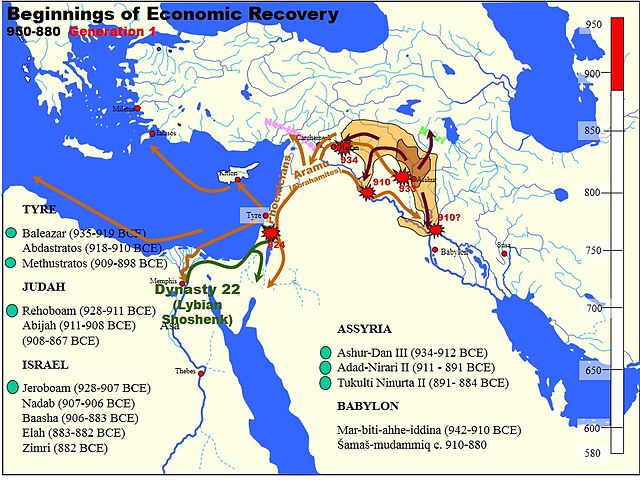Tiglath-Pileser III was the king of the Neo-Assyrian Empire from 745 BC to his death in 727. One of the most prominent and historically significant Assyrian kings, Tiglath-Pileser ended a period of Assyrian stagnation, introduced numerous political and military reforms and more than doubled the lands under Assyrian control. Because of the massive expansion and centralization of Assyrian territory and establishment of a standing army, some researchers consider Tiglath-Pileser's reign to mark the true transition of Assyria into an empire. The reforms and methods of control introduced under Tiglath-Pileser laid the groundwork for policies enacted not only by later Assyrian kings but also by later empires for millennia after his death.
Tiglath-Pileser III as depicted on a stele from the walls of his royal palace
Tiglath-Pileser III, depicted in a royal chariot in one of the reliefs from the royal palace in Nimrud
A wall painting from Til Barsip depicting Tiglath-Pileser (sitting) holding court. The official closest to him to the right is his son Shalmaneser V.
A relief from Nimrud depicting Tiglath-Pileser (right) trampling a defeated enemy
The Neo-Assyrian Empire was the fourth and penultimate stage of ancient Assyrian history. Beginning with the accession of Adad-nirari II in 911 BC, the Neo-Assyrian Empire grew to dominate the ancient Near East throughout much of the 8th and 7th centuries BC, becoming the largest empire in history up to that point. Because of its geopolitical dominance and ideology based in world domination, the Neo-Assyrian Empire is by many researchers regarded to have been the first world empire in history. It influenced other empires of the ancient world culturally, administratively, and militarily, including the Babylonians, the Achaemenids, and the Seleucids. At its height, the empire was the strongest military power in the world and ruled over all of Mesopotamia, the Levant and Egypt, as well as parts of Anatolia, Arabia and modern-day Iran and Armenia.
Assyrian borders and campaigns under Ashur-dan II (r. 934–912 BC), Adad-nirari II (r. 911–891 BC) and Tukulti-Ninurta II (r. 890–884 BC)
Annals of Tukulti-Ninurta II (r. 890–884 BC), recounting one of his campaigns
Stele of Ashurnasirpal II (r. 883–859 BC)
Assyrian borders and campaigns under Ashurnasirpal II (r. 883–859 BC)








